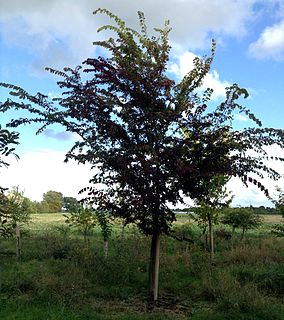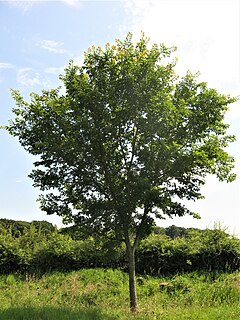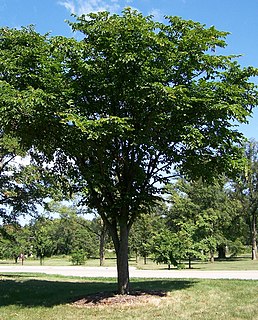
Ulmus crassifoliaNutt., the Texas cedar elm or simply cedar elm, is a deciduous tree native to south central North America, mainly in southern and eastern Texas, southern Oklahoma, Arkansas and Louisiana, with small populations in western Mississippi, southwest Tennessee and north central Florida; it also occurs in northeastern Mexico. It is the most common elm tree in Texas. The tree typically grows well in flat valley bottom areas referred to as 'Cedar Elm Flats'. The common name 'cedar elm' is derived from the trees' association with juniper trees, locally known as cedars.

Ulmus laciniata(Trautv.) Mayr, known variously as the Manchurian, cut-leaf, or lobed elm, is a deciduous tree native to the humid ravine forests of Japan, Korea, northern China, eastern Siberia and Sakhalin, growing alongside Cerciphyllum japonicum, Aesculus turbinata, and Pterocarya rhoifolia, at elevations of 700–2200 m, though sometimes lower in more northern latitudes, notably in Hokkaido.

Ulmus macrocarpaHance, the large-fruited elm, is a deciduous tree or large shrub endemic to the Far East excluding Japan. It is notable for its tolerance of drought and extreme cold and is the predominant vegetation on the dunes of the Khorchin sandy lands in the Jilin province of north-eastern China, making a small tree at the base of the dunes, and a shrub at the top.

Ulmus davidianaPlanch., the David, or Father David, elm, is a small deciduous tree widely distributed across China, Mongolia, Korea, Siberia, and Japan, where it is found in wetlands along streams at elevations of 2000–2300 m (6,500–7,500 ft). The tree was first described in 1873 from the hills north of Beijing, China.

Ulmus szechuanicaFang, known as the Szechuan (Sichuan), or red-fruited, elm, is a small to medium deciduous Chinese tree found along the Yangtze river through the provinces of Sichuan, Jiangxi, Anhui, and Jiangsu.

Ulmus 'Frontier' is an American hybrid cultivar, a United States National Arboretum introduction derived from a crossing of the European Field Elm Ulmus minor with the Chinese Elm Ulmus parvifolia in 1971. Released in 1990, the tree is a rare example of the hybridization of spring- and autumn-flowering elms. Tested in the US National Elm Trial coordinated by Colorado State University, 'Frontier' averaged a survival rate of 74% after 10 years.

Ulmus 'Morton Glossy' is a hybrid cultivar raised by the Morton Arboretum, Illinois. Originally named 'Charisma' until it was realized that name had already been registered for another plant, the tree was derived from a crossing of two other hybrid cultivars grown at the Morton: Accolade and Vanguard. Tested in the US National Elm Trial coordinated by Colorado State University, Triumph averaged a survival rate of 86% after 10 years. Triumph was introduced to the UK in 2006 by the Frank P. Matthews nursery in Worcestershire.
Ulmus 'Morton Plainsman' is a hybrid cultivar raised by the Morton Arboretum from a crossing of Siberian Elm and a Japanese Elm grown from openly pollinated seed donated by the Agriculture Canada Research Station at Morden, Manitoba. Tested in the US National Elm Trial coordinated by Colorado State University, Vanguard averaged a survival rate of 78% after 10 years.

Ulmus 'Morton Red Tip' is a hybrid cultivar raised by the Morton Arboretum from an open pollination of Accolade. The tree has occasionally been reported as a hybrid of Accolade with the Siberian Elm Ulmus pumila, an error probably owing to the commercial propagation of the tree by grafting onto U. pumila rootstocks. Tested in the US National Elm Trial coordinated by Colorado State University, Danada Charm averaged a survival rate of 77.5% after 10 years.

Ulmus 'Morton Stalwart', is a Morton Arboretum hybrid cultivar arising from a controlled crossing of Accolade with the hybrid of a Field Elm U. minor from eastern Russia and a Siberian Elm U. pumila. Tested in the US National Elm Trial coordinated by Colorado State University, Commendation averaged a survival rate of 85% after 10 years.
The Chinese Elm cultivar Ulmus parvifolia 'Burgundy' is a small American development.

The Chinese Elm cultivar Ulmus parvifolia 'Emer II' or 'Emerald Vase' was cloned from a tree planted circa 1910 on the University of Georgia campus at Athens.
The Chinese Elm cultivar Ulmus parvifolia 'Emer I' or 'Emerald Isle' was cloned from a tree planted circa 1920 on the University of Georgia campus at Athens.

The Chinese Elm cultivar Ulmus parvifolia 'Drake' was marketed by the Monrovia Nursery of Azusa, California from 1952–53.
The Chinese Elm cultivar Ulmus parvifolia 'Dynasty' is a United States National Arboretum introduction reputed to be very fast-growing.
The Chinese Elm cultivar Ulmus parvifolia 'Hallelujah' is one of three American introductions made circa 1992 that were selected for their cold hardiness. 'Hallelujah' is known to have withstood -37°C (-35°F) in Missouri.

Ulmus laciniata var. nikkoensisRehder, the Nikko elm, was discovered as a seedling near Lake Chūzenji, near Nikkō, Japan, and obtained by the Arnold Arboretum in 1905. The taxonomy of the tree remains a matter of contention, and has been considered possibly a hybrid of U. laciniata and U. davidiana var. japonica. However, in crossability experiments at the Arnold Arboretum in the 1970s, U. laciniata, a protogynous species, was found to be incompatible with U. davidiana var. japonica, which is protandrous.
The Chinese Elm cultivar Ulmus parvifolia 'Garden City Clone' was raised in Kansas. The champion tree was 18 m tall in 1993; however, the name 'Garden City Clone' is not officially recognized.
Ulmus parvifolia f. lanceolata, the Chinese elm, is a rare form endemic to South Korea.

Ulmus parvifolia, commonly known as the Chinese elm or lacebark elm, is a species native to eastern Asia, including mainland China, Taiwan, Japan, North Korea, South Korea and Vietnam. It has been described as "one of the most splendid elms, having the poise of a graceful Nothofagus".












